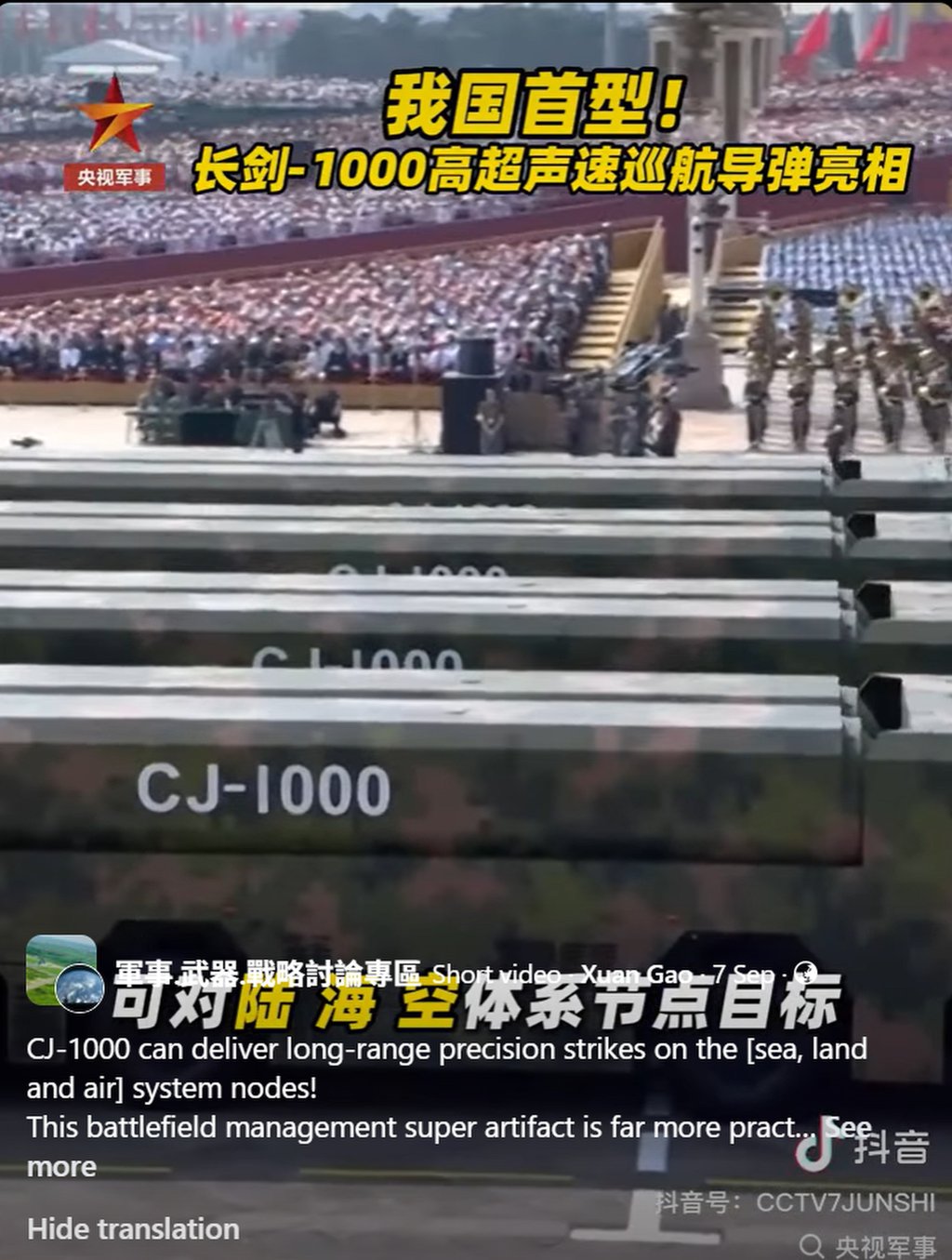explanation of new gadget; over to Anduril to do something :0)
The CJ-1000, potentially with a range exceeding 6,000km (3,728 miles), could be launched from mainland China or deployed aboard forward naval bases in the South China Sea. scmp.com
How deadly is CJ-1000, world’s first hypersonic plane killer? PLA war game gives hint
Ground cruise missile designed for ultra-long-range strikes could hit enemy targets from thousands of kilometres away

Stephen Chenin Beijing
Published: 10:00am, 19 Sep 2025Updated: 11:36am, 19 Sep 2025
Amid the roar of China’s military parade on September 3, a few trucks rolled through Tiananmen Square with camouflaged loads tagged “CJ-1000”.
The trucks were hauling surface-launched hypersonic cruise missiles also known as Long Sword-1000s – weapons designed for ultra-long-range strikes on “system-node targets on the ground, at sea or in the air”, according to Chinese state media.
China has not officially disclosed the detailed specifications of the CJ-1000. Though a new weapon must pass many rounds of field tests before entering service, no test results have yet been published by the authorities.
However, if the parade description is confirmed, the weapon could be the first hypersonic plane-killing missile that would rewrite the rules of aerial warfare.
It would allow the People’s Liberation Army (PLA) to strike high-value airborne assets such as aerial refuelling tankers, airborne early warning (AEW) aircraft, reconnaissance platforms from thousands of kilometres away, at speeds exceeding Mach 5.
The PLA has indicated it will mainly target command-and-control nodes, meaning any aircraft critical for entire military operations – including Air Force One – could be at risk.
While most hypersonic weapons under global development are targeting ground or sea targets, the CJ-1000 represents a paradigm shift in the PLA’s war strategy: reaching deep into enemy airspace to eliminate critical support aircraft before they can aid combat operations.
According to an August paper by researchers with China’s National Defence University (NDU), the PLA is actively simulating and training senior military commanders for the use of ultra-long-range surface-to-air weapons that would operate under much higher command authorities than traditional air defence weapons due to their unusually long range and strategic impact.

China’s CJ-1000 hypersonic cruise missile could rewrite the rules of aerial warfare. Photo: CCTV
Although the paper, titled “Methodology and Implementation of Comprehensive Ground-to-Air Combat Modelling in Large-Scale Computer Wargame Systems”, does not name the CJ-1000 directly, it describes a class of “campaign-level” ground-to-air weapons that require explicit authorisation from the top campaign-level commanders.
“Operations dominated by ultra-long-range weapons fall under the command authority of campaign-level or higher headquarters,” wrote the team led by senior war game engineer Wang Yanzheng from NDU’s College of Joint Operation.
“These operations have a significant impact on the overall campaign and involve extremely high costs, necessitating decisions by campaign-level commanders.
“In ultra-long-range surface-to-air engagement scenarios, campaign-level or higher commanders determine the timing and targets of strikes, placing the commander within the operational loop.
“For example, when using ultra-long-range air defence missiles to engage high-value aerial targets, the system provides situational awareness to the commander, and the ground-to-air engagement is conducted based on the commander’s decisions,” added Wang and his colleagues in the paper published in the peer-reviewed journal Command Control & Simulation.
These are contrasted with tactical-level air defences, which can be operated autonomously or under local command, according to the paper.
This aligns with the assessment by some military experts suggesting the CJ-1000 is designed to engage high-altitude, large, slow-moving aircraft – such as the US E-3 Sentry Awacs (Airborne Warning and Control System), KC-135/KC-46 refuellers or RC-135 surveillance planes – flying from Guam, Hawaii or even continental US bases.
Modern air warfare relies heavily on “force multipliers” – non-combat aircraft that provide early warning, electronic warfare support, data fusion and mid-air refuelling. Destroying or disrupting these platforms can cripple an entire air campaign, even without engaging fighter jets directly, according to these experts.
The CJ-1000, potentially with a range exceeding 6,000km (3,728 miles), could be launched from mainland China or deployed aboard forward naval bases in the South China Sea.
At hypersonic speeds, these missiles would give adversaries minimal reaction time, rendering traditional evasive manoeuvres nearly useless for large, non-manoeuvrable aircraft.
Moreover, flying at lower altitudes than ballistic missiles and with high manoeuvrability, thanks to an air-breathing scramjet engine, the CJ-1000 may evade current missile warning satellites and radar systems tuned to detect high-speed ballistic trajectories.
North Korea launches new hypersonic missile test ahead of Trump’s return to White House
The National Defence University study offers a rare glimpse into how the PLA envisions using such powerful weapons. Using a large-scale computer war game system, researchers modelled a “multilayer denial” air defence strategy involving three tiers.
The first is point-defence systems – autonomous systems used against drones and close-range threats.
Mid-to-long-range missiles – guided by preset engagement rules – would prioritise stealth targets or ballistic missiles.
Ultra-long-range systems such as CJ-1000 would be manually controlled by the campaign headquarters due to their strategic significance.
This tiered control reflects a deliberate effort to prevent escalation, ensuring that only top-level decision makers can unleash weapons capable of altering the strategic balance.
In simulated war games, the paper showed that the ultra-long-range system remained inactive until manually authorised, highlighting strict command-and-control protocols.
The emergence of a hypersonic surface-to-air missile like the CJ-1000 introduces profound strategic uncertainty. For decades, the US and its allies have relied on stand-off support aircraft operating beyond the range of conventional surface-to-air missiles. The CJ-1000 suggests that such sanctuary in deep rear areas may no longer be guaranteed. |




